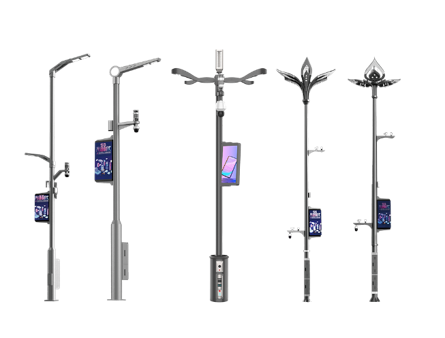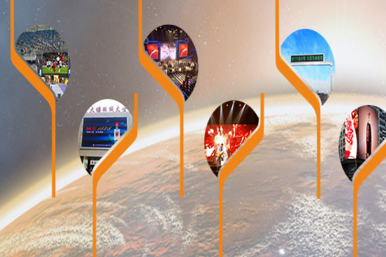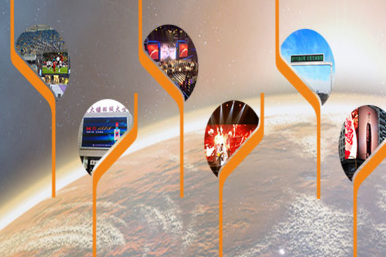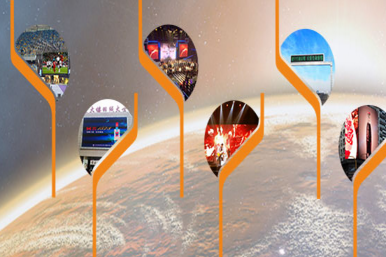Publisher: Supplier of LED Display Time: 2022-08-22 10:32 Views: 1618
In recent years, local governments have accelerated the pace of smart city construction. According to the forecast of the China Smart City Working Committee, the size of my country's smart city market will reach 25 trillion yuan this year. The construction of new smart cities is closely related to the development of the times. In the face of the impact of the new crown pneumonia epidemic, digital applications such as health codes and cloud live broadcasts have effectively contributed to the resumption of work and production and the supply of living materials. How to improve the city's ability to deal with crises and how to build a more intelligent city has become a problem that needs to be considered in the construction of a new type of smart city.
The construction of a new smart city is inseparable from the "three generals"
In the construction of a new smart city, digital information infrastructure is the cornerstone, the city brain is the intelligent center, and rich application scenarios are an important way to release potential, becoming an indispensable "three generals".
First, digital information infrastructure is the cornerstone of new smart city construction. At present, the construction of digital information infrastructure represented by 5G, optical fiber broadband, data centers, etc. in my country is constantly accelerating, and the world's largest 5G network and optical fiber network have been built, providing important support for the construction of smart cities. With the characteristics of high reliability, low latency, and large bandwidth, 5G injects strong impetus into the development of telemedicine, online education, and high-definition live broadcast. It can also effectively open up various urban services, integrate and improve the efficiency of resource utilization, and drive the gradual improvement of urban governance. Toward intelligence, improve the quality of life of residents.
Secondly, the city brain is the intelligent center for the overall coordination of the new smart city. When General Secretary Xi Jinping inspected the Hangzhou City Brain Operation Command Center, he pointed out that the city brain is an important measure to build a "digital Hangzhou". Using cutting-edge technologies such as big data, cloud computing, blockchain, and artificial intelligence to promote innovation in urban management methods, management models, and management concepts, from digitization to intelligence to intelligence, to make cities smarter and smarter, is to promote The only way to modernize the urban governance system and governance capacity is with broad prospects. At present, local governments are promoting the construction of urban brains one after another, and the number of related projects is increasing.
Finally, application scenarios are an important way for new smart cities to unleash their potential. Entering the "14th Five-Year Plan" period, urban development will pay more attention to the needs of people's livelihood such as residents' travel, education and medical care, and public safety, as well as the industrial needs of enterprises to improve quality and efficiency, and to transform and upgrade. The application scenarios of new smart cities are constantly enriched, and urban governance is more refined. change. For example, with the normalization of epidemic prevention and control, public travel has increased, but in subways, airports, bus stations and other places, masks need to be removed to brush their faces, increasing the risk of cross-infection, and face recognition wearing masks has gradually become a reality. Correspondingly, at this stage, some subway stations, hospitals, and communities have supported wearing masks for face verification, reducing the probability of infection and shortening the travel time.

Five measures to promote the high-quality development of new smart cities
The high-quality development of new smart cities requires both strong foundations and development.
1. Accelerate infrastructure construction and consolidate the foundation of smart cities
Accelerate the deployment of digital information infrastructure such as 5G, gigabit optical networks, and data centers, and promote the construction of a city's global perception system.
First, pay attention to the balance of infrastructure layout. Promote the scientific and rational allocation of digital information infrastructure between cities and rural areas, central and western regions, and between emerging industries and traditional manufacturing and resource industries, and support the development of digital economy in more regions and the improvement of quality and efficiency in more industries.
Secondly, pay attention to the linkage with the new urbanization construction. Relevant data shows that the overall size of my country's smart community market will reach 643.3 billion yuan in 2023, and smart communities will become an important part of new smart cities. Accelerate the promotion of new technologies such as 5G and the Internet of Things to enable the intelligent transformation of municipal public facilities, improve the coverage of urban gigabit optical networks and the experience of home users, and promote the construction of smart communities with "suitable for the elderly" and "livable" as the starting point.
Finally, focus on implementing the green and low-carbon development strategy. At present, the development of the digital economy is accelerating, the amount of data is growing explosively, and the demand and scale of data centers have surged. Bring energy saving and emission reduction benefits.
2. Break through key technologies and build a secure base for smart cities
Smart cities mainly involve digital technologies such as big data, Internet of Things, artificial intelligence, cloud computing, and digital twins. However, my country has not yet achieved autonomous control in some key technical fields. Taking the Internet of Things as an example, my country’s perception and recognition layer at the bottom of the industrial chain has relatively weak technical strength, and the core basic theoretical research and key technology research still need to be strengthened. Key devices such as sensors still rely on Western developed countries, increasing the risk of information leakage.
To make breakthroughs in key technical fields, we need to make efforts from the following two aspects to ensure the smooth operation of the new smart city. First, integrate resources to speed up core technology research. Upstream and downstream enterprises in the industrial chain, government, industry, academia, research and users will form a joint force to improve the Internet of Things infrastructure, combine system innovation with key breakthroughs, optimize the supply of smart city-related products and services, and jointly promote the replacement of domestically produced software and hardware products. Second, improve the standardization level. Improve the standard system in the fields of smart city, Internet of Things, big data, etc., strengthen the research on standard interoperability, promote the integration and development of industries, actively participate in the formulation of international standards, and improve the consistency of domestic and foreign standards.
3. Focus on data operation and release the core value of smart city
The report "Insights into the Development Status and Trends of China's Digital Economy" shows that my country has become one of the countries with the largest amount of data and the most abundant types of data. Data contains enormous value and potential, and has become an important asset for smart cities.
In terms of data integration and sharing, unified regulations need to be made for data collection, storage, opening, classification dimensions, download formats, platform interface standards, etc. in the fields of urban transportation, medical care, education, industry, etc. Connectivity and horizontal connectivity”. For example, jointly release local epidemic prevention and control requirements and traffic control information to break through "logistics obstruction".
In terms of data value release, strengthen government-enterprise cooperation and enterprise linkage, continuously improve the functional details of the data sharing platform, encourage enterprises and institutions to deeply mine public data, and actively develop more convenient services and enterprise applications around the problem of urban governance blockages , to accelerate the release of data value.
In terms of data security, adhere to the two-wheel drive of technology and management, strengthen the research and pilot application of key data security technologies from a technical perspective, and establish a security mechanism covering the entire process of data collection, transmission, storage, use, and opening from a management perspective, and Dynamically adjust security strategies and technical measures based on actual needs, and strengthen risk perception and monitoring and early warning capabilities.
4. Give full play to the driving role of scenarios and accelerate the implementation of smart city applications
Adhere to the people-oriented development idea, focus on solving the difficulties of urban governance, and use information technology to promote comprehensive innovative applications across departments, levels, and regions through current and future demand traction.
Increase support for grassroots needs. During the epidemic prevention and control period, some basic-level micro-units such as communities, towns, and commercial buildings still use traditional air defense methods, such as manual registration, temperature measurement and other "form-based epidemic prevention" methods. It is necessary to strengthen technical defense strategies such as 5G, cloud computing, big data, artificial intelligence, etc., and sink various applications of smart cities into the micro-unit governance link. Help smart applications "top-down" to improve the design.
Improve the ability to respond to emergencies. The epidemic has exposed the relatively weak ability of many cities to deal with emergencies. In the future, rapid response to sudden needs should be strengthened, and efforts should be made in smart medical care, personnel and material allocation with the idea of "combining peace and war". Taking the deployment of emergency materials as an example, the smart city platform can quickly coordinate the needs of residents for materials, and quickly open up the blocking points in key links such as supply, transportation, connection, supervision, and distribution, and effectively realize the coordination of various departments.
5. Optimize the operation mechanism and establish a cooperative ecosystem
A good operation mechanism is an important factor for the long-term operation of a smart city, and it is also the focus of the sustainable development of a smart city at present and in the future.
Explore multiple investment models. Smart cities cover many fields such as urban operation, industrial development, and social and people's livelihood. Each field is a huge and complex system engineering. By innovating the co-construction, sharing and co-governance model, the responsibilities and benefits of each investor can be clarified, and the government, large and medium-sized enterprises, scientific research institutes and non-profit institutions can be mobilized to participate in the construction, and a value cooperation ecosystem can be established.
Improve the operation evaluation system. Before the smart city is put into operation, the overall planning such as schedule and acceptance criteria should be clarified, and specific assessment indicators, such as the quantity of infrastructure and user satisfaction, should be designed. A third-party evaluation agency can be introduced, and the third-party evaluation results can be used as the basis for project payment and acceptance to promote construction and reform to improve the construction and operation level of smart cities in the new era.
Source: People's Daily









